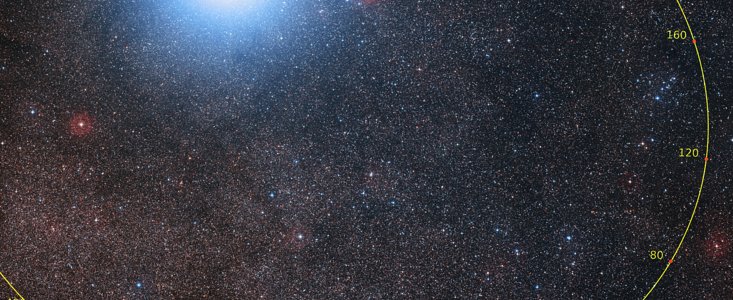Mitteilung
Umlaufbahn von Proxima Centauri nach 100 Jahren bestimmt
Bislang stärkster Beleg dass Proxima Centauri das Alpha Centauri-Paar umkreist
22. Dezember 2016
Das Interesse an unserem Nachbar-Sternsystem Alpha Centauri ist besonders hoch, seit vor kurzem ein Exoplanet entdeckt wurde, der Proxima b genannt wird und den dritten Stern des Systems umkreist, den sonnennächsten: Proxima Centauri. Während das größere Sternpaar des Systems, Alpha Centauri A und B, eine Eigenbewegung am Himmel zu haben scheint, die der des kleineren, schwächeren Proxima Centauri sehr ähnlich ist, war es bislang nicht möglich zu zeigen, dass die drei Sterne eigentlich ein einziges, gravitativ gebundenes Dreier-Sternsystem bilden.
Jetzt sind die drei Astronomen Pierre Kervella, Frédéric Thévenin und Christophe Lovis zu dem Schluss gekommen, dass die drei Sterne tatsächlich ein gebundenes System darstellen. In den hundert Jahren seit der Entdeckung von Proxima Centauri war es aufgrund seiner geringen scheinbaren Helligkeit schwierig, seine Radialgeschwindigkeit verlässlich zu messen – die Geschwindigkeit also, mit der er sich zur Erde hin und von ihr weg bewegt. Jetzt aber hat das Planetenjäger-Instrument HARPS der ESO eine extrem präzise Messung der Radialgeschwindigkeit von Proxima Centauri geliefert. Bei der Erklärung anderer kleiner Effekte wurde eine sogar noch höhere Genauigkeit erreicht. [1]
Die Astronomen waren in der Lage, für die Radialgeschwindigkeiten des Alpha Centauri-Paares und von Proxima sehr ähnliche Werte abzuleiten – was der Vorstellung, dass es sich um ein gebundenes System handelt, Glaubwürdigkeit verleiht. Unter Berücksichtigung dieser neuen Messungen zeigen Berechnungen der Umlaufbahnen der drei Sterne, dass die relative Geschwindigkeit zwischen Proxima Centauri und dem Alpha-Centauri-Paar ein gutes Stück unterhalb der Schwelle liegt, über der die drei Sterne nicht mehr durch ihre gegenseitigen Anziehungskräfte aneinander gebunden wären.
Dieses Ergebnis hat bedeutende Auswirkungen auf unser Verständnis des Alpha Centauri-Systems und der Entstehung seiner Planeten: Es legt nahe, dass Proxima Centauri und das Alpha Centauri-Paar gleich alt sind (ungefähr sechs Millionen Jahre). Das wiederum erleichtert die Schätzungen des Alters vom umlaufenden Planeten Proxima b.
Die Forscher vermuten, dass der Planet in größerer Entfernung um Proxima Centauri entstanden sein könnte und dann in seine aktuelle Position sehr nah an seinen Mutterstern gebracht wurde – als Ergebnis des dichten Abstands zwischen Proxima Centauri und dessen Cousins im Alpha Centauri-Paar. Alternativ könnte der Planet auch um das Alpha Centauri-Paar herum entstanden sein und später durch die Schwerkraft von Proxima Centauri eingefangen worden sein. Falls eine dieser Hypothesen zutrifft, ist es möglich, dass der Planet einst eine Eiswelt war, die geschmolzen ist und auf deren Oberfläche sich nun flüssiges Wasser befindet.
Endnoten
[1] Messungen der Stern-Geschwindigkeiten wurden durch die Beobachtung bestimmter Merkmale in ihrem Licht bzw. ihrer Spektrallinien vorgenommen. Gewisse physikalische Effekte können die beobachteten Wellenlängen in diesen Linien verändern, was zu Fehlern in der Geschwindigkeitsmessung führt. Wenn ein Stern eine instabile Oberfläche hat, kann er eine so genannte konvektive Blauverschiebung der Spektrallinien verursachen, während die Schwerkraft zu einer gravitativen Rotverschiebung führen kann.
Weitere Informationen
Die Ergebnisse werden in einem Fachartikel veröffentlicht, das im Journal Astronomy & Astropysics erscheint.
Das Team besteht aus P. Kervella, CNRS UMI 3386, Universität von Chile, und LESIA, Observatorium Paris, F. Thévenin, Observatorium der Côte d’Azur, Frankreich, sowie Christophe Lovis, Observatorium der Universität Genf, Schweiz.
Kontaktinformationen
Pierre Kervella
Universidad de Chile, CNRS UMI 3386 & LESIA, Observatoire de Paris
Camino El Observatoria 1515, Las Condes
Santiago, Chile
E-Mail: pkervell@das.uchile.cl
Frédéric Thévenin
Observatoire de la Côte d'Azur
Boulevard de l’Observatoire
Nizza, Frankreich
E-Mail: Frederic.Thevenin@oca.eu
Tel: +33 4 92 00 30 26
Christophe Lovis
Observatoire astronomique de l’Université de Genève,
51 Ch. des Maillettes,
1290 Versoix, Schweiz
E-Mail: christophe.lovis@unige.ch
Peter Grimley
ESO Assistant Public Information Officer
Garching bei München
Tel: +49 89 3200 6383
E-Mail: pgrimley@partner.eso.org
Über die Mitteilung
| ID: | ann16089 |

